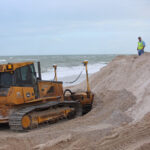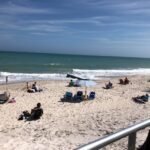INDIAN RIVER COUNTY – The north county beach restoration project is scheduled to restart Feb. 7, with updated surveys in hand and the go-ahead from state regulatory agencies in place.
Trucks will begin hauling sand to Treasure Shores Park Beach for distribution from Feb. 7 to late March before moving to Golden Sands for a month to complete the project by the end of April.
The scheduled work is the second phase of the Sector 3 beach restoration and will place approximately 250,000 cubic yards of sand on a 2.3- mile stretch of beach between Seaview and Orchid.
County Commissioners opted last year to forgo pumping offshore sand from dredges as had been employed in two previous beach restoration projects.
Instead, they decided to truck sand in from local mines.
However, due to delays in getting the project off the ground, officials ended up using outdated 2007 coastal surveys and they had to adjust the quantity of sand needed from 200,000 cubic yards to 317,000 cubic yards leading to cost increases for the project.
“In Phase 1, we were working off older surveys,” said County Coastal Engineer James Gray. “For Phase 2 we will be working off surveys from September 2010.”
With Phase 1 completed and a learning curve in place from that project, officials are expecting to avoid the bottlenecks at the mines that slowed the delivery of sand last year.
“We have authorized the mining companies to start stockpiling the sand so they can do the sorting and sifting and washing that needs to be done to complete the processing to meet the permit requirements,” said Commissioner Peter O’Bryan, who is a member of the Beach and Shore Preservation Advisory Committee.
“Where the delays came in Phase 1 was that Ranger Construction (the contractor running the project) could haul and spread the sand faster than the mines could produce and process it,” O’Bryan added.
Commissioners agreed last summer to pre-pay Ranger Construction part of the $15.56 per cubic yard it is charging the county to test, truck and grade sand from Ranch Road and Fischer mines for the current project.
Ranger has reported that approximately 85,000 cubic yards of sand has been stockpiled between the Ranch Road Lake (75,000 cubic yards) and Fischer (10,000 cubic yards) mines.
County commissioners agree to prepay Ranch Road $7.50 per cubic yard for its sand and Fischer $6.16 for the sand it stockpiles.
“With the sand we have stockpiled now, that should reduce any delays,” said Gray.
Gray added that the county has passed all the permitting and testing as a result of the Phase 1 project, including a determination that that upland sand did not adversely affect turtle nesting season.
Failure to pass that test would have derailed the project. If Phase 2 stays on schedule officials estimate it will take 69 days to complete, including five days allotted for weather delays.
Public Works Director Chris Mora has said he expects the peak truck traffic for Phase 2 to run between February and March.
Coastal Engineer Gray reported to the Beach Shores and Preservation Advisory Committee last June that no complaints were received about the truck traffic and only minimal asphalt damage was sustained.
The trucks will follow the same route as last year and run at the same two- to three-minute frequency roughly between 7 a.m and 6 p.m.
The trucks will travel eastbound on State Road 510 and north on A1A to either Golden Sands Park or Treasure Shores Park as necessary.
The entire Sector 3 Beach Restoration Project extends 6.6 miles from the Seaview development south to John’s Island.
To date approximately 4.3 miles of the project has been fully constructed from Orchid south to John’s Island – placing over 300,000 total cubic yards of sand.
Commissioner O’Bryan said if the project remains on the schedule and all the sand is delivered in the February to April timeframe, the only remaining work would be for Ranger Construction to return in May for some plantings to help reduce the speed of the beach erosion.
Thus far it has cost $14.9 million for the Sector 3 project, with those costs shared by the county and the Sebastian Inlet Taxing Authority.
The next beach restoration project under consideration is Sector 5 from Tracking Station south to the city of Vero Beach.
That project is at least a few years away due to a requirement put in place by Vero Beach that any beach restoration project within city limits must be approved by city-wide referendum.






